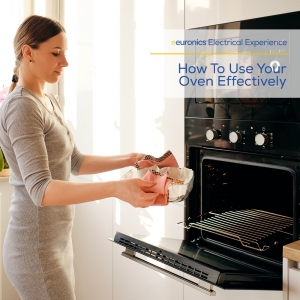How to use your oven effectively
28th Nov 2022

An oven is a necessity for most kitchens, most families use them every day. But are you using it to the best of its ability? By understanding your oven’s functions better, you can cook your favourite food better than ever before. From slow roasting to grilling, there are lots of handy tips to help you. Keep reading to find out more.
Cook according to your oven type
Your oven’s controls and programmes will vary depending on whether it’s a gas or electric model. Electric ovens typically offer more even heating, whereas temperatures in gas ovens may fluctuate.
To cook in an electric oven, simply adjust the temperature and oven function dials to suit the food you’re cooking. As gas ovens are a little trickier to use, we’ve put together some helpful tips below.
Tips for cooking in gas cookers
Gas ovens are a top choice for chefs and bakers as they allow precise temperature control. However, they require a little extra care to ensure optimal results. Follow our top tips to ensure your food is cooked thoroughly, without the risk of over cooking:
- Rotate the food: Heat is less consistent in a gas oven, so there may be higher and lower spots. Rotate your baking trays slightly during cooking to ensure great results
- Use a baking stone: As strange as it might sound, a baking stone can help to regulate temperature. Simply place it at the bottom of your oven and add your food above
- Avoid dark metal cookware: Heat comes from the bottom of the oven in gas models. Dark metal cookware absorbs heat faster, potentially leading to unwanted browning and burning. Opt for lighter-coloured metals, glass, or silicone instead
- Watch out for a strong gas smell: If you smell gas coming from your oven, open all windows and check the switch on the oven is turned off. If this isn’t the cause, turn off the gas mains, and ask a gas engineer to inspect your gas supply, connections, and appliances
Choose a cooking function
When you turn on your oven, you’ll need to select a cooking function to provide optimum results. These are the main types and their purposes:
- Fan: Offers faster cooking times and lower energy consumption
- Conventional: Heat is moved around by convection – ideal for roasting and baking
- Grill: Crisps, browns, and toasts food.
- Heating element functions: The bottom element is perfect for adding crispy bases to foods like pizza. The upper element can brown the top of dishes like lasagne.
More specialist functions offer optimum settings to cook specific foods, for example, bread baking and dough proving. Rapid heat modes also reach temperatures faster – ideal if you’re in a rush. Defrosting functions save time waiting for ice to thaw, so you can cook frozen food easily.
Allow your oven to pre-heat fully before adding food – a light or alarm should indicate once it’s ready. Otherwise, use an oven thermometer to check the temperature. Thermometers are particularly useful for gas ovens, where temperatures tend to fluctuate.
The food packaging will provide cooking times depending on each function, but you may decide to cook longer for browning or crisping.
Select an oven level
Decide which oven rack will give the best results. If you’re cooking multiple items at once, think about which rack will best suit each item:
- Top Rack: Used for high temperatures, fast cooking, and browning. Be careful of burning
- Middle Rack: Ideal for cooking most foods at a moderate temperature. Often cooks more evenly
- Bottom Rack: Great for lower temperatures and slow cooking.
Tips for getting top results from your oven
- Avoid opening the oven door, especially when baking. Wait until your timer sounds and judge by appearance and smell
- Keep your oven clean to avoid directing heat to burnt on food
- Use the oven’s timer (if applicable) to prevent burning or undercooking
- Choose cookware to suit the food. Glass and ceramic hold heat most effectively, while metal achieves all-over browning
- Add a crispy or browned finish by cooking longer than stated. Or use a blast of heat – around 25 degrees higher should do the trick
- Electric ovens can be quite dry, preventing bread and cakes from rising effectively. Adding a pan of hot water to the bottom of the oven will add steam to help them along.
Follow our tips and cook up tasty treats for the whole family with your oven. Whether it’s gas or electric, make the most of your appliance to roast, brown, crisp, and more.
Click to view our range of ovens




